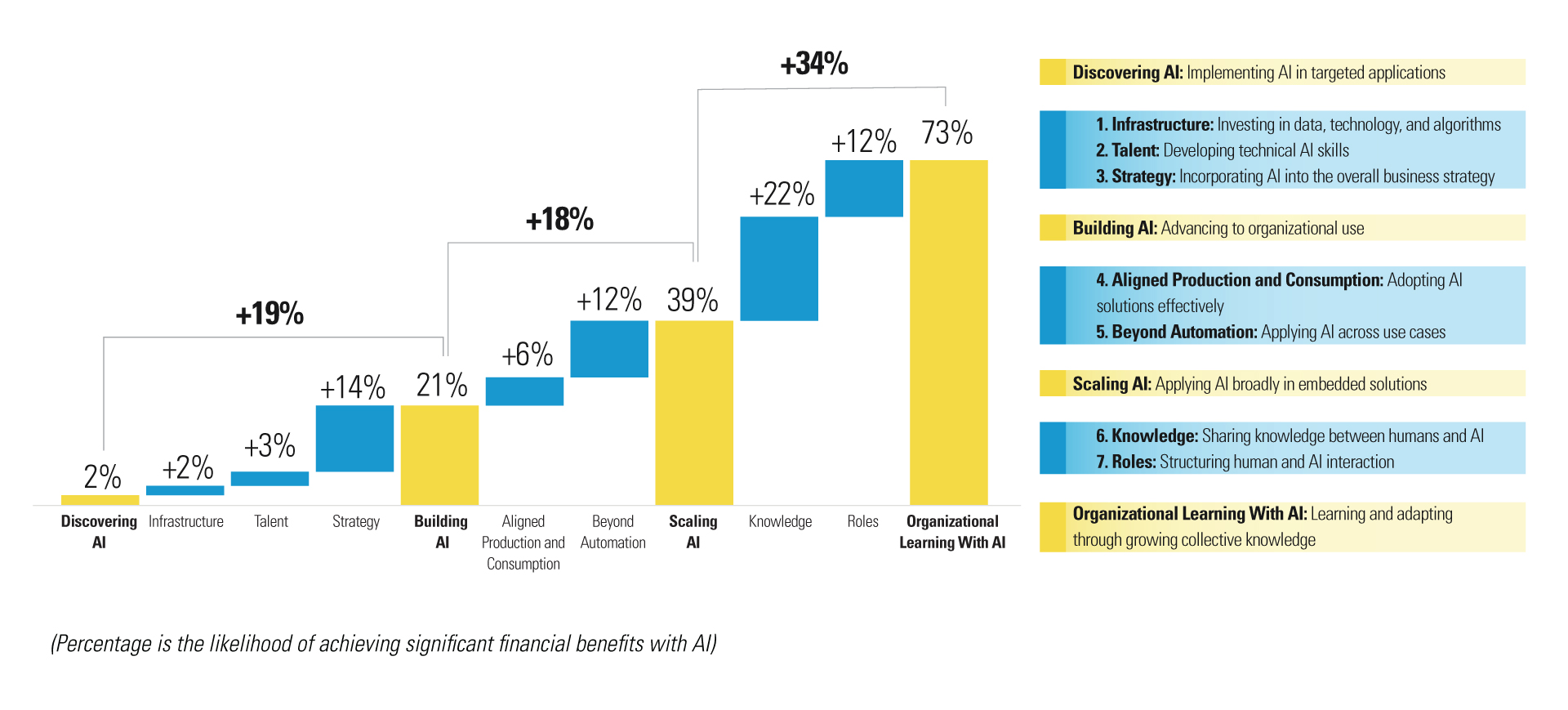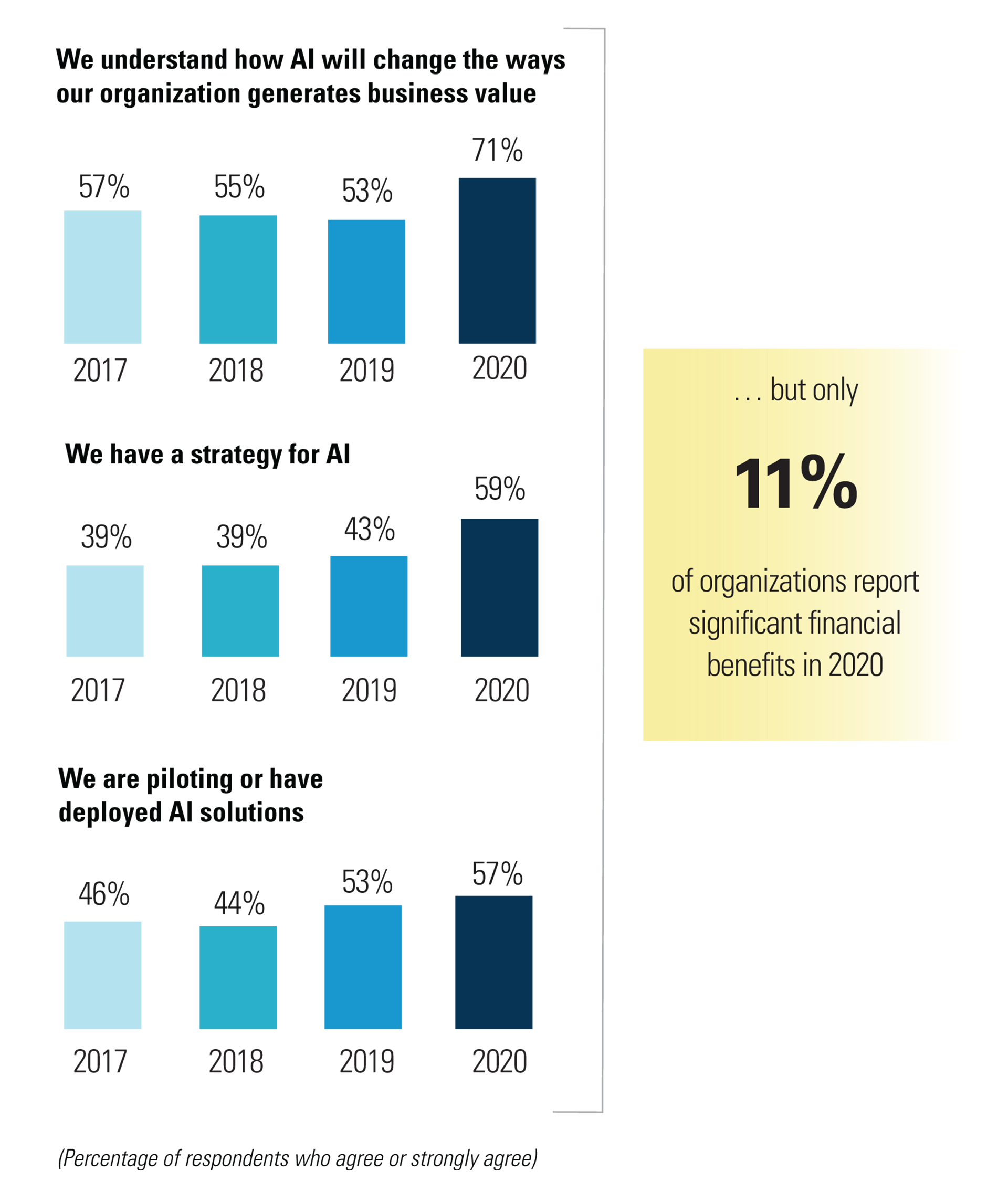MIT Sloan Management Review, in collaboration with
BCG – Boston Consulting Group
By Sam Ransbotham, Shervin Khodabandeh, David Kiron, François Candelon, Michael Chu, and Burt LaFountain
Findings from the 2020 Artificial Intelligence Global Executive Study and Research project
Key Messages:
- Only 10% of companies obtain significant financial benefits with artificial intelligence technologies. Why so few?
-
- getting the basics right — like having the right data, technology, and talent, organized around a corporate strategy — is far from sufficient.
-
- Only 20% of companies achieve significant financial benefits with these fundamentals alone.
- Only when organizations add the ability to learn with AI do significant benefits become likely. Their strategic focus is organizational learning, not just machine learning.
-
- Our research shows that these companies intentionally change processes, broadly and deeply, to facilitate organizational learning with AI.
-
- With organizational learning, the odds of an organization reporting significant financial benefits increase to 73%.
- Organizations that learn with AI have three essential characteristics:
-
- They facilitate systematic and continuous learning between humans and machines.
-
- They develop multiple ways for humans and machines to interact.
-
- They change to learn, and learn to change.
- These organizations don’t just change processes to use AI; they change processes in response to what they learn with AI. Organizational learning with AI demands, builds on, and leads to significant organizational change.
- Seven activities dramatically increase the likelihood that an organization will achieve significant financial benefits with AI.

Executive Summary
Only 10% of companies obtain significant financial benefits with artificial intelligence technologies. Why so few?
Our research shows that these companies intentionally change processes, broadly and deeply, to facilitate organizational learning with AI.
Better organizational learning enables them to act precisely when sensing opportunity and to adapt quickly when conditions change.
Their strategic focus is organizational learning, not just machine learning.
Organizational learning with AI is demanding.
It requires humans and machines to not only work together but also learn from each other — over time, in the right way, and in the appropriate contexts.
This cycle of mutual learning makes humans and machines smarter, more relevant, and more effective. Mutual learning between human and machine is essential to success with AI. But it’s difficult to achieve at scale.
Our research — based on a global survey of more than 3,000 managers, as well as interviews with executives and scholars — confirms that:
- a majority of companies are developing AI capabilities
- but have yet to gain significant financial benefits from their efforts.
Figure 1: Few organizations see significant benefits with AI
Despite increasing AI understanding, strategy development, and use, few organizations report significant financial benefits with AI.

More than half of all respondents affirm that their companies are piloting or deploying AI (57%), have an AI strategy (59%), and understand how AI can generate business value (70%).
These numbers reflect statistically significant increases in adoption, strategy development, and understanding from four years ago.
What’s more, a growing number of companies recognize a business imperative to improve their AI competencies.
Despite these trends, just 1 in 10 companies generates significant financial benefits with AI.
We analyzed responses to over 100 survey questions to better understand what really enables companies to generate significant financial benefits with AI.
We found that:
- getting the basics right — like having the right data, technology, and talent, organized around a corporate strategy — is far from sufficient.
- Only 20% of companies achieve significant financial benefits with these fundamentals alone.
Getting the basics right and building AI solutions that the business wants and can use improve the odds of obtaining significant financial benefits, but to just 39%.
Our key finding:
- Only when organizations add the ability to learn with AI do significant benefits become likely.
- With organizational learning, the odds of an organization reporting significant financial benefits increase to 73%.
Organizations that learn with AI have three essential characteristics:
- They facilitate systematic and continuous learning between humans and machines.
- They develop multiple ways for humans and machines to interact.
- They change to learn, and learn to change.
1.They facilitate systematic and continuous learning between humans and machines.
Organizational learning with AI isn’t just machines learning autonomously.
Or humans teaching machines.
Or machines teaching humans.
It’s all three.
Organizations that enable humans and machines to continuously learn from each other with all three methods are five times more likely to realize significant financial benefits than organizations that learn with a single method.
2.They develop multiple ways for humans and machines to interact.
Humans and machines can and should interact in different ways depending on the context. Mutual learning with AI stems from these human-machine interactions. Deploying the appropriate interaction mode(s) in the appropriate context is critical.
For example, some situations may require an AI system to make a recommendation and humans to decide whether to implement it.
Some context-rich environments may require humans to generate solutions and AI to evaluate the quality of those solutions.
We consider five ways to structure human-machine interactions.
Organizations that effectively use all five modes of interaction are six times as likely to realize significant financial benefits compared with organizations effective at a single mode of interaction.
3.They change to learn, and learn to change.
Structuring human and machine interactions to learn through multiple methods requires significant, and sometimes uncomfortable, change.
Organizations that make extensive changes to many processes are five times more likely to gain significant financial benefits compared with those that make only some changes to a few processes.
These organizations don’t just change processes to use AI; they change processes in response to what they learn with AI.
Organizational learning with AI demands, builds on, and leads to significant organizational change.
This report offers a clear, evidence-based view about how to manage organizational learning with AI.
Figure 3: Achieving learning with AI
Seven activities dramatically increase the likelihood that an organization will achieve significant financial benefits with AI.

- Discovering AI
- Building AI
- Scaling AI
- Organizational learning with AI
1.Discovering AI. AI implementations in targeted areas can (even in isolation) occasionally yield surprisingly sizable returns.
For example, a sophisticated model that reduces customer churn can, by itself, create substantial value.
Organizations that are still developing their infrastructure, talent, and strategy to embrace AI have some small potential (2%) of realizing more than incremental value.
While 2% certainly isn’t a high probability, it attests to the potential of AI even in targeted (but important) applications.
2.Building AI. To advance from targeted applications to organizational use of AI, companies invest in data, technology, and algorithms to build AI capabilities.[1]
They marshal the technical skills necessary to capitalize on those investments.[2]
Their overall business strategy inherently incorporates the capabilities of AI, without relegating AI to a side strategy.[3]
Organizational efforts in these areas increase their probability of becoming Leaders from 2% to 21%. But even this tenfold increase doesn’t garner more than an absolute chance of 1 out of 5 for significant financial benefits.
3.Scaling AI. Adding the ability to embed AI into processes and solutions improves the likelihood of significant benefits dramatically, but only to 39%.
Several factors contribute to this improvement.
With many technology options, effectively scaling AI overcomes the difficulty of matching the right technology to a specific problem.
From the production side, embedding AI deeply and broadly within processes demonstrates that an organization can solve problems and execute projects effectively. From the consumption side, managers throughout the organization learn more about how to use AI, how AI models work, and how much (or how little) confidence to put in them.
4.Scaling AI is clearly about more than enterprise-wide process automation.
Organizations that effectively produce and consume AI create some business value.[4]
However, the absolute chance of obtaining significant financial benefits with discovering, building, and scaling AI is still much less than 50%.
Organizational learning with AI. Some organizations almost double again their prospects of obtaining significant financial benefits with AI (to 73%). How? They create opportunities for mutual learning between humans and AI.
They haven’t just learned to teach machines what they, as humans, know; they’ve learned how to use human-machine interactions to refine processes quickly as circumstances change.
They haven’t uncovered a single prescriptive structure for human and machine roles in processes; they’ve learned how to adapt human and machine roles to each situation.
Growing collective organizational knowledge, in the form of both digital data and human experience, supports ever-improving decision-making.
Organizational learning with AI becomes a systematic, continuous process of improvement.
Both aspects — ensuring that people and AI learn from each other, and structuring effective ways to work together — require significant, complex changes to an organization.
No wonder so few of them have learned how to learn with AI.
About the authors:
SAM RANSBOTHAM, is a professor in the information systems department at the Carroll School of Management at Boston College, as well as guest editor for MIT Sloan Management Review’s Artificial Intelligence and Business Strategy Big Ideas initiative.
SHERVIN KHODABANDEH, is a senior partner and managing director at BCG, and the co-leader of BCG GAMMA (BCG’s AI practice) in North America. He can be contacted at shervin@bcg.com.
DAVID KIRON, is the editorial director of MIT Sloan Management Review, where he directs the publication’s Big Ideas program. He can be contacted at dkiron@mit.edu.
FRANÇOIS CANDELON, is a senior partner and managing director at BCG, and the global director of the BCG Henderson Institute.
MICHAEL CHU, is a partner and associate director at BCG, and a core member of BCG GAMMA.
BURT LAFOUNTAIN is a partner and managing director at BCG, and a core member of BCG GAMMA.
SPECIAL CONTRIBUTORS
Rodolphe Charme di Carlo and Allison Ryder
To cite this report, please use:
Ransbotham, S. Khodabandeh, D. Kiron, F. Candelon, M. Chu, and B. LaFountain, “Expanding AI’s Impact With Organizational Learning,” MIT Sloan Management Review and Boston Consulting Group, October 2020.
Originally published at: https://sloanreview.mit.edu
https://sloanreview.mit.edu/projects/expanding-ais-impact-with-organizational-learning/
https://web-assets.bcg.com/f1/79/cf4f7dce459686cfee20edf3117c/mit-bcg-expanding-ai-impact-with-organizational-learning-oct-2020.pdf












